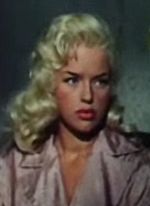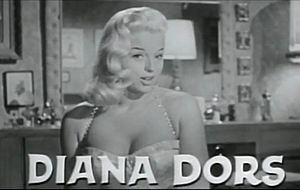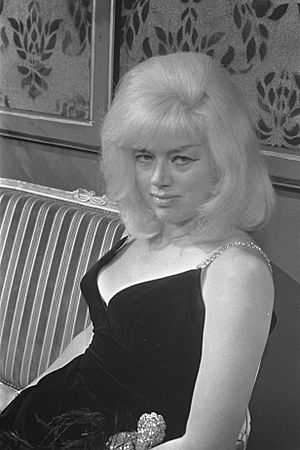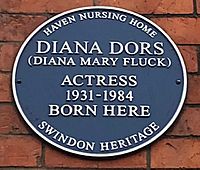Diana Dors facts for kids
Quick facts for kids
Diana Dors
|
|
|---|---|
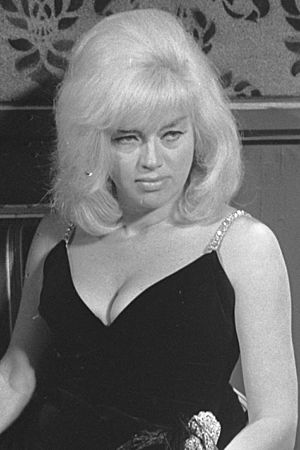
Dors in 1968
|
|
| Born |
Diana Mary Fluck
23 October 1931 |
| Died | 4 May 1984 (aged 52) Windsor, Berkshire, England
|
| Resting place | Sunningdale Catholic Cemetery |
| Other names | Diana d'Ors The Siren of Swindon The Hurricane in Mink The Blonde Bombshell |
| Education | Colville House, Swindon |
| Alma mater | London Academy of Music and Dramatic Art |
| Occupation |
|
| Years active | 1947–1984 |
| Spouse(s) |
Dennis Hamilton
(m. 1951; died 1959)Alan Lake
(m. 1968) |
| Children | 3, including Mark Dawson |
Diana Dors (born Diana Mary Fluck; 23 October 1931 – 4 May 1984) was a famous English actress and singer.
She first became well-known as a "blonde bombshell," a term for a very attractive and glamorous woman, similar to American stars like Marilyn Monroe. Later in her career, Diana showed her skills on TV, in music, and in live shows. She became very popular as a guest on chat shows and also gave strong performances in many films.
Contents
Early Life and First Steps in Acting
Diana Mary Fluck was born in Swindon, Wiltshire, England, on 23 October 1931. Her mother was Winifred Maud Mary (Payne) and her father was Albert Edward Sidney Fluck, who worked for the railway.
Diana went to a private school called Selwood House in Swindon. She was eventually asked to leave the school because she often misbehaved during lessons. From a young age, Diana loved going to the cinema. Her favorite actresses were Veronica Lake, Lana Turner, and Jean Harlow.
Towards the end of World War II, Diana entered a beauty contest to find a "pin-up girl" for Soldier Magazine. A pin-up girl was a popular image of an attractive woman that soldiers would display. Diana came in third place, which led to her working as a model for art classes. She also started acting in local plays like A Weekend in Paris.
Learning to Act at LAMDA
Diana was very good at speaking clearly and performing. Even though she was only 14, she was accepted to study at the London Academy of Music and Dramatic Art (LAMDA) in January 1946. She was the youngest student there.
While studying, she lived at the Earls Court YWCA. To earn extra money, she posed for the London Camera Club. She quickly showed great talent, winning a bronze medal and then a silver medal with honors.
Her First Film Roles
Before joining LAMDA, Diana tried out for a part in the film Black Narcissus but didn't get it. Her first chance to act in a movie came when a casting director saw her in a LAMDA play. She was given a small speaking role in the film The Shop at Sly Corner (1947). She was paid £8 for three days of work.
Before signing her contract, her mother suggested she change her last name to Dors, which was her maternal grandmother's maiden name. This is how Diana Mary Fluck became Diana Dors.
Soon after, she got another role in Holiday Camp (1947) and then in Dancing with Crime (1947), where she acted alongside Richard Attenborough. She was paid £10 per day for these roles. In spring 1947, she graduated from LAMDA, winning an award for the "girl most likely to succeed in films."
Joining the Rank Organisation
The Charm School Years
At 15, Diana signed a contract with The Rank Organisation, a major British film company. She joined their "Charm School," which trained young actors. Other famous students included Petula Clark and Christopher Lee. Diana didn't enjoy the Charm School, but she received a lot of attention because she was happy to be photographed in glamorous poses and attend movie premieres. People even nicknamed her "The Body."
Her first films with Rank included a small part in The Calendar (1948) and a bigger role in Good-Time Girl (1948). She also played Charlotte in the famous film Oliver Twist (1948), directed by David Lean.
Diana got her first important role as the second female lead in Penny and the Pownall Case (1948). A writer named Bob Monkhouse was very impressed by her energy and vitality in the film.
In 1948, Rank announced they planned to make Diana a big star. She then appeared in A Boy, a Girl and a Bike (1949) and had a funny supporting role in Here Come the Huggetts (1948). She was so popular in this film that she returned for the sequel, Vote for Huggett (1949).
Becoming a Leading Lady
Rank gave Diana leading roles starting with Diamond City (1949), a story set in South Africa. She was only 17 years old during filming.
In 1950, she was loaned to Ealing Studios for Dance Hall, where she was one of four main female characters. Although she called it a "ghastly film," her performance received good reviews.
Diana also performed in a play called Man of the World in 1950, which earned her the Theatre World magazine's Actress of the Year Award. However, Diamond City didn't do well at the box office. Because Rank was in debt, they closed their "Charm School" and let Diana go in September 1950.
British Stardom and Hollywood Dreams
Diana quickly found new work, starring in the comedy Worm's Eye View (1951), which became very popular in Britain. She also had a leading role in a BBC TV movie, Face to Face (1951).
Marriage to Dennis Hamilton
In May 1951, Diana met Dennis Hamilton Gittins while filming Lady Godiva Rides Again. They married just five weeks later.
Diana then starred in a British crime film called The Last Page (1952). Dennis Hamilton worked hard to boost Diana's career. He even arranged for her to lease a Rolls-Royce at age 20, making headlines as the youngest person in the UK to own one.
Diana was offered a lead role in a Hollywood film by Burt Lancaster, but Hamilton turned it down without telling her. This meant her early career stayed mostly in British films.
More Films and Stage Work
In 1952, Diana appeared in a stage show called Rendezvous. Her film career improved when she was cast in My Wife's Lodger (1952) and The Great Game (1953). She was paid £1,000 for her role in Is Your Honeymoon Really Necessary? (1953).
Her career took a big leap forward with a supporting role in the prison drama The Weak and the Wicked (1954). The film was a huge success in Britain and earned Diana excellent reviews. By this time, she was reportedly earning £12,000 a year.
She then played a lead role in A Kid for Two Farthings (1955), which was also very popular. In 1955, British movie theater owners voted her the ninth-most popular British star at the box office, and the only woman in the top ten.
Diana made another film with director J. Lee Thompson, Yield to the Night (1956), where she played a character similar to a real-life figure named Ruth Ellis. This role brought her some of the best reviews of her career and she was praised at the 1956 Cannes Film Festival.
Hollywood Calling
Her success led to interest from Hollywood. In 1956, Diana signed a contract with RKO Pictures to make several movies. She traveled to Hollywood, where she filmed The Unholy Wife (1957) with Rod Steiger. She was reportedly paid $75,000 for this film.
To celebrate her arrival, a big party was held at a friend's house in Hollywood. Many famous stars attended, including Doris Day and John Wayne. During the party, Diana and her husband were pushed into a swimming pool, which led to negative headlines in the newspapers.
After returning to Britain, she made The Long Haul (1957) with Victor Mature. She also went to Italy to film The Love Specialist (1957).
Her RKO films did not do well, and RKO ended her contract. In 1958, RKO claimed she had become "an object of disgrace." Diana sued the studio and later settled for $200,000.
Back to Hollywood and Britain
After having her first child in 1960, Diana appeared in some American films, including the comedy On the Double (1961) with Danny Kaye. She also sold her life story to a newspaper.
In 1961, she filmed an episode for Alfred Hitchcock Presents called "The Sorcerer's Apprentice." This episode was considered too scary and was not shown for many years.
Diana then returned to Britain and appeared in films like Mrs. Gibbons' Boys (1962). She also guest starred on American TV shows like Burke's Law and The Alfred Hitchcock Hour. In 1963, she toured Australia.
Later Career and TV Stardom
Diana divorced her second husband, Richard Dawson, in 1966 and moved back to the UK. She faced financial difficulties and declared bankruptcy in 1968.
Her film roles became mostly supporting parts in movies like Berserk! (1967) with Joan Crawford and Deep End (1970). In 1970, she returned to the West End stage for the first time in 17 years.
Success on Television
Diana became a TV star playing the main role in the comedy series Queenie's Castle (1970–72). She also appeared in other popular TV shows like Z Cars, Dixon of Dock Green, and The Sweeney.
Her film work during this period included Hannie Caulder (1971), The Pied Piper (1972), and Theatre of Blood (1973).
Final Years and Public Popularity
In her later years, Diana's popularity grew even more, especially through her television work. Her quick wit and intelligence made her a favorite guest on chat shows and game shows like Jokers Wild and Blankety Blank. She also had a regular role in The Two Ronnies.
Younger music artists also wanted to work with her. She appeared in the 1981 music video for Adam and the Ants' song Prince Charming, playing a fairy godmother.
Diana also wrote several autobiographical books, sharing stories from her life. She was the subject of the TV show This Is Your Life twice, in 1957 and 1982.
In the early 1980s, Diana co-wrote a diet book and created a diet and exercise video. She also had a regular segment on the TV breakfast show TV-am, giving advice on diet and other topics.
Her final film appearance was in Steaming (1985), which was released after her death.
Music Recordings
Diana Dors also had a singing career. Her first recordings were released in 1953. She recorded one full album in 1960 called Swingin' Dors, which featured swing music. She also released several singles throughout the 1960s, 70s, and early 80s. One of her last singles, "Where Did They Go?", was a duet with her son, Gary Dawson.
Personal Life
Diana Dors was married three times:
- Dennis Hamilton Gittins: They married in 1951 and he passed away in 1959. They did not have children.
- Richard Dawson: They married in 1959 and divorced in 1966. They had two sons, Mark Dawson and Gary Dawson.
- Alan Lake: They married in 1968. They had one son, Jason Lake. Alan Lake was with her until her death.
Death
Towards the end of her life, Diana Dors battled cancer. She had surgery twice to remove cancerous tumors. She passed away on 4 May 1984, at the age of 52, from ovarian cancer. She was buried in Sunningdale Catholic Cemetery.
Remembering Diana Dors in Swindon
Diana Dors is remembered in her hometown of Swindon.
A large bronze statue of Diana Dors, created by artist John Clinch, was put up outside a cinema in West Swindon in 1991. It shows her wearing an evening gown.
In 2017, a blue plaque was placed on the building where she was born in Swindon. Her son Jason Dors-Lake and granddaughter Ruby Lake unveiled the plaque. Her pink Cadillac car from 1959, which was a gift to her, was parked outside for the event.
The Swindon Museum and Art Gallery has a bronze bust (a sculpture of her head and shoulders) of Diana Dors by artist Enid Mitchell. It was first displayed in the Wyvern Theatre in 1988 before being moved to the museum.
Filmography
| Year | Title | Role | Notes |
|---|---|---|---|
| 1947 | The Shop at Sly Corner | Mildred | Uncredited |
| 1947 | Dancing with Crime | Annette | Uncredited |
| 1947 | Holiday Camp | Dancer | Uncredited |
| 1948 | The Calendar | Hawkins | |
| 1948 | Good-Time Girl | Lyla Lawrence | |
| 1948 | Penny and the Pownall Case | Molly James | |
| 1948 | Oliver Twist | Charlotte | |
| 1948 | My Sister and I | Dreary Girl | |
| 1948 | Here Come the Huggetts | Diana Hopkins | |
| 1949 | Vote for Huggett | Diana Gowan | |
| 1949 | It's Not Cricket | Blonde | |
| 1949 | A Boy, a Girl and a Bike | Ada Foster | |
| 1949 | Diamond City | Dora Bracken | |
| 1950 | Dance Hall | Carole | |
| 1951 | Worm's Eye View | Thelma | |
| 1951 | Lady Godiva Rides Again | Dolores August | |
| 1952 | The Last Page | Ruby Bruce | |
| 1952 | My Wife's Lodger | Eunice Higginbotham | |
| 1953 | The Great Game | Lulu Smith | |
| 1953 | Is Your Honeymoon Really Necessary? | Candy Markham | |
| 1953 | The Saint's Return | The Blonde in Lennar's Apartment | |
| 1953 | It's a Grand Life | Corporal Paula Clements | |
| 1954 | The Weak and the Wicked | Betty Brown | |
| 1955 | As Long as They're Happy | Pearl Delaney | |
| 1955 | A Kid for Two Farthings | Sonia | |
| 1955 | Miss Tulip Stays the Night | Kate Dax | |
| 1955 | Value for Money | Ruthine West | |
| 1955 | An Alligator Named Daisy | Vanessa Colebrook | |
| 1956 | Yield to the Night | Mary Hilton | |
| 1957 | The Long Haul | Lynn | |
| 1957 | The Unholy Wife | Phyllis Hochen | |
| 1958 | The Love Specialist | Diana Dixon | |
| 1958 | I Married a Woman | Janice Blake Briggs | |
| 1958 | Tread Softly Stranger | Calico | |
| 1958 | Passport to Shame | Vicki | |
| 1960 | Scent of Mystery | Winifred Jordan | |
| 1961 | On the Double | Sergeant Bridget Stanhope | |
| 1961 | King of the Roaring '20s: The Story of Arnold Rothstein | Madge | |
| 1962 | Mrs. Gibbons' Boys | Myra | |
| 1963 | West 11 | Georgia | |
| 1964 | The Counterfeit Constable | Diana Dors | |
| 1966 | The Sandwich Man | First Billingsgate Lady | |
| 1967 | Danger Route | Rhoda Gooderich | |
| 1967 | Berserk! | Matilda | |
| 1968 | Hammerhead | Kit | |
| 1969 | Baby Love | Liz | |
| 1970 | Deep End | Mike's First Lady Client | |
| 1970 | There's a Girl in My Soup | His Wife | |
| 1971 | Hannie Caulder | Madame | |
| 1972 | The Pied Piper | Frau Poppendick | |
| 1972 | The Amazing Mr. Blunden | Mrs. Wickens | |
| 1972 | Swedish Wildcats | Margareta | |
| 1973 | Nothing but the Night | Anna Harb | |
| 1973 | Theatre of Blood | Maisie Psaltery | |
| 1973 | Steptoe and Son Ride Again | Woman In Flat | |
| 1974 | From Beyond the Grave | Mabel Lowe | |
| 1974 | Craze | Dolly Newman | |
| 1975 | The Amorous Milkman | Rita | |
| 1975 | What the Swedish Butler Saw | Madame Helena | |
| 1975 | Bedtime with Rosie | Aunt Annie | |
| 1975 | Three for All | Mrs. Ball | |
| 1976 | Adventures of a Taxi Driver | Mrs. North | |
| 1976 | Keep It Up Downstairs | Daisy Dureneck | |
| 1977 | Adventures of a Private Eye | Mrs. Horne | |
| 1979 | Confessions from the David Galaxy Affair | Jenny Stride | |
| 1985 | Steaming | Violet | Released posthumously |
Television Roles
| Year | Title | Role | Notes |
|---|---|---|---|
| 1951 | Face to Face | Angel | TV film |
| 1951 | How Do You View? | Cuddles | 6 episodes |
| 1954 | Rheingold Theatre | Angie | Episode: "The Lovely Place" |
| 1960 | Armchair Theatre | Jane Francis | Episode: "The Innocent" |
| 1960 | The Red Skelton Hour | Joan Williams | Episode: "George Appleby's Neighbor" |
| 1961 | The Jack Benny Program | Lady Milbeck | Episode: "English Sketch" |
| 1961 | Straightaway | Photographer | Episode: "The Sportscar Breed" |
| 1962 | Alfred Hitchcock Presents | Irene Sadini | Episode: "The Sorcerer's Apprentice" |
| 1963 | The Alfred Hitchcock Hour | Nickie Carole | Episode: "Run for Doom" |
| 1963 | Burke's Law | Maxine Borman | Episode: "Who Killed Alex Debbs?" |
| 1964 | The Eleventh Hour | Carol Devon | Episode: "87 Different Kinds of Love" |
| 1964 | Armchair Theatre | Grace Maxwell | Episode: "A Nice Little Business" |
| 1968 | The Inquisitors | Sweet P. Lawrence | Episode: "The Peeling of Sweet P. Lawrence" |
| 1968 | Boy Meets Girl | Megan Norton-Grey | Episode: "Where Have All the Ghosts Gone?" |
| 1970–1972 | Queenie's Castle | Queenie Shepherd | All 18 episodes |
| 1971 | The Misfit | Maggie | Episode: "On Superior Persons" |
| 1971 | A Taste of Honey | Helen | All 3 episodes |
| 1971 | Z Cars | Madge Owen | 2 episodes |
| 1972 | Dixon of Dock Green | Maisie Dewar | Episode: "The Informant" |
| 1973 | All Our Saturdays | Di Dorkins | All 6 episodes |
| 1975 | Thriller | Bessy Morne | Episode: "Nurse Will Make It Better" |
| 1977–1978 | Just William | Mrs. Bott | 7 episodes |
| 1978 | The Sweeney | Mrs. Rix | Episode: "Messenger of the Gods" |
| 1979 | Of Mycenae and Men | Helen of Troy | TV film |
| 1979 | The Plank | Woman with Rose | TV film |
| 1980 | Hammer House of Horror | Mrs. Ardoy | Episode: "Children of the Full Moon" |
| 1980 | Shoestring | Maggie | Episode: "Looking for Mr Wright" |
| 1980 | Dr. Jekyll and Mr. Hyde | Kate Winterton | TV film |
| 1980 | The Two Ronnies | The Commander | 4 episodes |
| 1981 | BBC Television Shakespeare | Timandra | Episode: "Timon of Athens" |
| 1981 | Dick Turpin | Mrs. Buskin | Episode: "Dick Turpin's Greatest Adventure: Part 4" |
| 1984 | Cannon and Ball | Miss Scarlett | Episode: #5.5 |
Stage Appearances
- The Cat and the Canary (1949)
- The Good Young Man (1949)
- Lysette (1949)
Images for kids
See also
 In Spanish: Diana Dors para niños
In Spanish: Diana Dors para niños


